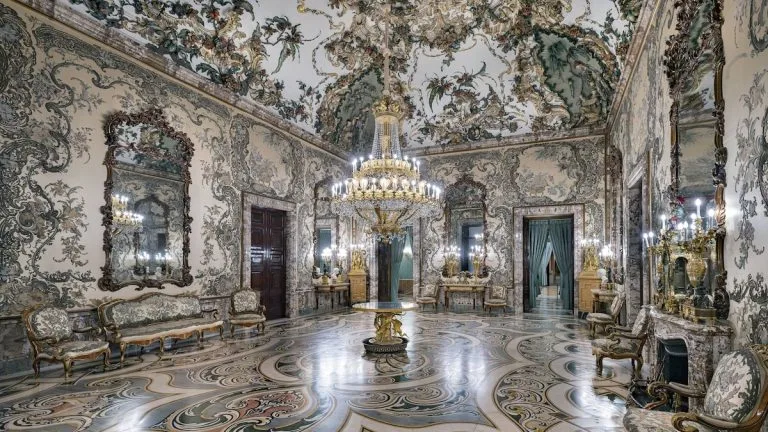The new portraits of Don Felipe and Dona Letizia are already part of the great works of the Bank of Spain collection The pictures were taken last February by famous American photographer Annie Lebovitz and she chose the place herself: The Gasparini Room, one of the most original rooms in the Royal Palace of Madrid. The hall, originally conceived by Charles III for private visitors, has had various uses over time and has witnessed the history of Spain. Now, thanks to the unique atmosphere and Leibovitz’s characteristic look, we see his appearance change using light space.
The diptych composition of this royal portrait shows a two-part sequence. On the left, King Philip VI wears the gala uniform and is surrounded by all the elements of a classic portrait: mirror, table, a magnificent chandelier, El Pastor clock (which is present in the portrait of the national heritage gem and a way for time), an open door with curtains. On the right, Queen Letizia enters the chamber, flooded with natural light, stripped of the features that mark her majesty (the royal tiara and Charles III’s sash) and using none of the elements typical of ceremonial portraits. It is a combination that, from the Bank of Spain’s point of view, manages to calibrate two strong images, but close, royal, but human and, above all, artistically interesting and historically relevant.
Mario Mateos, Curator of the Royal Palace in Madrid, told us about the curiosities of a very fine and very well-preserved room.
The Gasparini Salon, the chosen venue, is itself a work of art, designed in the Rococo style by a Venetian-born painter who came from Naples with Charles III when he became King of Spain in 1759. In the 18th century, the king dressed in this room in front of his court, and over time we spoke to the curator of the Royal Palace of Madrid about it and other curiosities.
‘This place is the most original of all European palaces. Birds, peonies, oriental figures and fleshy foliage fill every centimeter of the room…’
“On a technical level it is One of the most complex of the royal palaces in Madrid; So much so, that when Charles III died in 1788, only the marble floor and vault were finished, the latter decorated with reliefs and plaster figures, imitating porcelain. The rest of the decorative elements of the Gasparini complex – hangings and furniture – were gradually installed in the 19th century. The hanging, embroidered in satin with colored silk and golden silver thread, was made in a workshop run by Maria Luisa Bergonzini, wife of Mattia Gasparini. It was placed in the room during the reign of Ferdinand VII. The furniture, also designed by Gasparini and placed in the hall during the reign of Alfonso XII, was made in a workshop run by the German-born cabinet maker José Canopes, who had been called to the court from Paris. We have come across one of the richest seats in terms of its design and its technique. We use these pieces to create S-shaped armrests, fine woodwork or “indias” wood – so called in the 18th century because they came from America – or embroidered upholstery that matches the hangings of the room”, says Amara Mateos.
‘At present, and during gala lunches and dinners, it serves as a coffee room, a function it has retained since the reign of Elizabeth II.’
“All elements respond to fashion chinoiserieReinterpreted by Gasparini in a masterful way that makes this place the most original of all European palaces. Birds, peonies, oriental figures and fleshy foliage fill every centimeter of the room,” adds Mateos. “This room is in an excellent state of preservation. It was extensively restored in the 90s of the 20th century.At that time the hanging was interfered with by transferring the embroidery to a new satin. In any case, it is a very delicate room, and things like light must be observed, which is very harmful to organic materials, such as the silk of the walls and seats, “explains the conservator of the Royal Palace of Madrid.” The use of these rooms has varied throughout their history. From pieces of Charles III’s wardrobe, to King Ferdinand VII’s chamber. Currently, and during gala lunches and dinners, it serves as a coffee room, a function it has maintained since the reign of Elizabeth II,” he explains.
“In the room we found Other notable elements that do not conform to the decoration designed by GaspariniLike the lamp, a French period piece by Ferdinand VII, or the El Pasteur clock by Swiss clockmaker Jaquet-Droz, acquired by Ferdinand VI,” the curator of the Royal Palace of Madrid tells us. In that sense, it should be noted that the clock, along with a variety of automatons An intricate jewel that adorns its case, appearing in the portrait of Felipe VI is no coincidence, as it is “Una”. A vehicle to appear again in the portrait gallery. Thus the invisible line connects Leibovitz with Banks’ first portrait painter: Francisco de Goya.“The poster accompanying the portrait at the first exhibition where it will be shown to the public explains, Tyranny of ChromosCurated by Yolanda Barros and which can be visited at the Bank of Spain until next March







